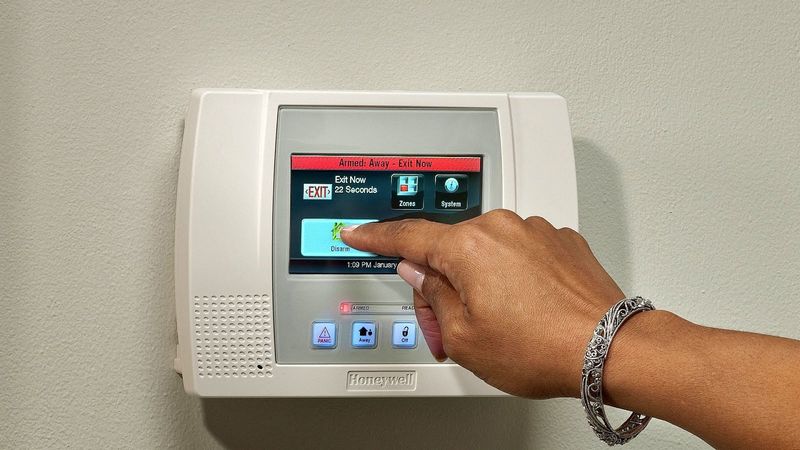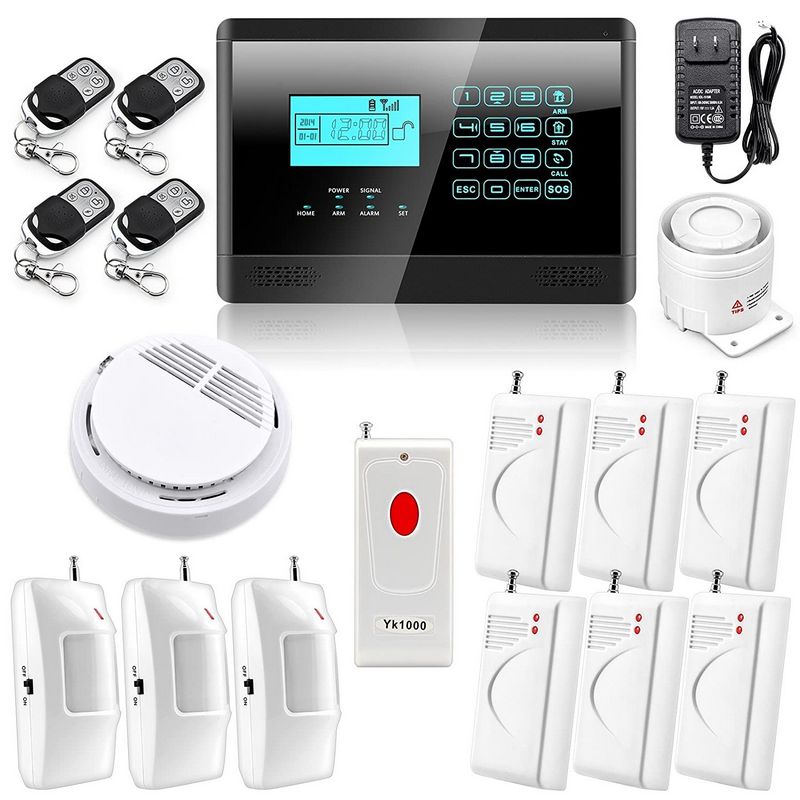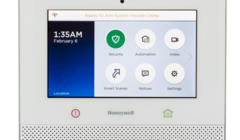
History And Timeline Of Home Security Systems
In today’s world, security systems have become an essential part of our lives. We rely on them to protect our homes and loved ones from potential threats. But have you ever wondered how these systems came into existence? The history of home security systems dates back to ancient times when people used various methods to safeguard their dwellings.
During ancient civilizations, homes were often targets of theft and vandalism. As a result, people developed innovative ways to protect their properties. They used techniques such as fortifying walls, placing guards, and creating secret passages to enhance security. These primitive security systems might not have been as sophisticated as the ones we have today, but they laid the foundation for future advancements in home security technology.
Fast forward to the 19th century, when the industrial revolution brought significant changes to society. With the invention of the telegraph, people began to explore ways to use this technology for security purposes. In 1853, the first electric burglar alarm system was patented by Augustus Russell Pope. This rudimentary system used electromagnetic contacts to sound an alarm when a door or window was opened. This invention marked the beginning of the modern era of home security systems.
Over the years, home security systems continued to evolve and become more sophisticated. In the 20th century, the development of electrical and electronic components paved the way for more advanced security systems. In the 1930s, closed-circuit television (CCTV) was introduced, allowing homeowners to monitor their properties remotely. The invention of motion sensors in the 1960s further enhanced home security by detecting movement and triggering alarms.
Today, home security systems have reached new heights with the advent of modern technology. Wireless systems, smart devices, and artificial intelligence have revolutionized the way we protect our homes. From smartphone-controlled security cameras to voice-activated alarms, homeowners now have access to a wide range of cutting-edge security features. As technology continues to advance, it’s exciting to think about what the future holds for home security systems.
The Birth of Home Security
In the history of security systems, the concept of home security is not a recent development. Home security has been a concern for humans since ancient times. As societies evolved, so did the methods and technologies used to protect homes.
The timeline of the birth of home security can be traced back to ancient civilizations, such as the Egyptians and the Greeks. These early cultures recognized the need to secure their homes from intruders and employed various measures to achieve this.
One of the earliest recorded methods used to protect homes was the use of guards, both human and animal. Guards were stationed around homes to keep watch and deter potential intruders. In some cases, trained animals such as dogs were used to patrol the premises.
As technology advanced, so did the security systems used in homes. In the Middle Ages, we see the emergence of mechanical locks. These locks were made of metal and operated by inserting a key and turning it to secure the door.
With the advent of electricity in the 19th century, home security systems took another leap forward. Electric alarm systems were introduced, which relied on electrical circuits to detect and alert homeowners of any unauthorized entry.
Fast forward to modern times, and we find ourselves in the era of smart home security systems. These systems utilize advanced technologies such as sensors, cameras, and network connectivity to provide comprehensive security for homes.
From ancient times to modern technology, the history and timeline of home security systems demonstrate the continuous evolution of methods and technologies used to protect homes and ensure the safety of its occupants.
Home security systems have come a long way, from the simple guards of ancient civilizations to the complex and interconnected systems of today. The need for security has always been a fundamental human concern, and as technology continues to advance, we can only expect further innovations in the field of home security.
Early Methods of Home Security
One of the earliest methods of home security was the use of guards. Wealthy individuals would hire guards to protect their homes and families. These guards were often armed and would patrol the premises to ensure the safety of the household. This method provided a physical presence and acted as a deterrent to potential intruders.
Another method that was commonly used was the installation of locks on doors and windows. These early locks were simple in design but served as an effective means of securing a home. People would use various types of locks, such as wooden bars, metal chains, and padlocks, to secure their doors and windows.
In addition to guards and locks, some ancient civilizations even used animals for home security. Dogs, for example, were trained to protect homes and alert their owners of potential threats. Dogs were valued for their ability to sense danger and their loyalty to their owners. They were often kept outside the home as a first line of defense.
Despite the primitive nature of these early methods, they laid the foundation for the development of modern home security systems. Over time, advancements in technology have revolutionized the way we secure our homes, leading to the sophisticated systems we have today.
From guards and locks to the intricate surveillance systems and smart home technology of the present, the timeline of home security systems is a testament to our ongoing drive to protect our homes and loved ones.
In conclusion, the early methods of home security involved the use of guards, locks, and even animals to protect homes. These methods served as the basis for the development of more advanced security systems in the future.
Ancient Home Security Systems
Ancient civilizations devised various systems to protect their homes and belongings. While modern home security systems rely on advanced technology, these ancient systems used ingenious methods to deter intruders and ensure the safety of their homes.
- Moats: Many ancient civilizations, such as the Ancient Egyptians and Romans, built moats around their homes as a form of protection. These water-filled ditches acted as a physical barrier against invaders, making it difficult for them to approach the home.
- Locks and Keys: The ancient Egyptians developed sophisticated lock mechanisms made of wood and metal to secure their homes. These locks were accompanied by intricate keys that were often worn as symbols of power and status.
- Guard Dogs: Ancient civilizations, including the Greeks and Romans, used guard dogs to protect their homes. These dogs were trained to bark at intruders and could quickly alert homeowners of potential threats.
- Fortified Walls: Many ancient civilizations, such as the Mayans and Aztecs, built fortified walls around their cities and homes. These walls were designed to withstand attacks and discourage potential invaders.
- Alarm Systems: In ancient Rome, some homes were equipped with crude alarm systems. These systems consisted of strings, bells, and rattling objects that would make noise when someone tried to enter the home unauthorized.
Although these ancient home security systems may seem primitive in comparison to modern technology, they served as effective deterrents against intruders and played a crucial role in keeping homes and belongings safe.
Medieval Approaches to Home Security
In the medieval period, home security systems were much simpler compared to modern technology. The primary focus was on physical barriers and deterrents to protect homes from intruders.
One common approach to home security was the use of fortified structures, such as castles or walled cities. These structures were designed with high walls, strong gates, and moats to prevent unauthorized entry. Guards were positioned at strategic points to monitor and defend against potential invaders.
Another method employed during this time was the use of locks and keys. Simple locks made from wood or metal were used to secure doors, chests, and other valuable possessions. Keys were often kept by the homeowner or trusted individuals to prevent unauthorized access.
In addition to physical measures, medieval homeowners also relied on community support for security. Neighbors would band together to form watch groups, patrolling the streets and reporting any suspicious activities. This communal approach helped create a sense of safety and collective responsibility.
Although the medieval era lacked advanced technological systems, these approaches to home security were effective in their time. They emphasized the importance of physical barriers, dependable locks, and community vigilance for ensuring the safety of homes and communities.
| Fortified structures (castles, walled cities) |
| Locks and keys |
| Community watch groups |
Renaissance Innovations in Home Security
The Renaissance period marked a significant advancement in home security technologies. As society became more prosperous and homeowners sought to protect their valuable possessions, innovative solutions began to emerge.
| Year | Innovation |
| 15th century | Locks and Keys: The use of locks and keys became more widespread as locksmiths refined their craft. Intricate mechanisms were developed, making it increasingly difficult for unauthorized individuals to gain access to homes. |
| 16th century | Peepholes and Spy Holes: Homeowners started installing small holes in their doors to observe visitors without fully exposing themselves. This allowed them to identify potential threats before opening the door. |
| 17th century | Alarms: Mechanical devices were invented that emitted loud sounds when triggered. These alarms alerted homeowners and the surrounding community to the presence of an intruder, discouraging further attempts at burglary. |
| 18th century | Barred Windows: Homeowners began reinforcing their windows with metal bars or grilles. This prevented unauthorized entry while still allowing for natural light and ventilation. |
| 19th century | Security Guards: With the rise of urbanization, wealthy homeowners employed security guards to patrol their properties. These guards provided additional protection against theft and vandalism. |
These Renaissance innovations laid the foundation for modern home security systems. They demonstrated society’s ongoing efforts to protect the home and its inhabitants from potential threats.
Industrial Revolution and Home Security
The Industrial Revolution, which occurred in the late 18th and early 19th centuries, brought about significant changes in home security systems.
With the advent of industrialization, new technologies emerged that revolutionized the way people protected their homes. One such innovation was the development of the telegraph, which allowed for faster communication over long distances.
Telegraph systems quickly became integral to home security, as they enabled households to be connected to central monitoring stations. This meant that immediate assistance could be summoned in the event of a break-in or other emergency.
Additionally, the Industrial Revolution saw advancements in lock technology. Traditional locks were replaced with more sophisticated and secure systems, such as the lever tumbler lock, which offered increased protection against unauthorized entry.
The introduction of the electric alarm system during this period further enhanced home security. Electric alarms could be installed in homes, and they would trigger an audible alarm or notify a central monitoring station when there was a breach in security.
Overall, the Industrial Revolution marked a turning point in the evolution of home security systems. The advancements in technology during this time period greatly improved the effectiveness and efficiency of protecting homes, providing homeowners with greater peace of mind.
The Emergence of Modern Home Security Systems
The history of home security systems has come a long way since ancient times. From simple locks and barricades to advanced technological solutions, the timeline of home security systems showcases the evolution of protecting our homes.
In the early years, homeowners heavily relied on physical barriers like locks, gates, and walls to secure their homes. However, these measures were often susceptible to breaches and required constant human intervention.
It wasn’t until the mid-20th century that the first electronic home security systems emerged. These systems incorporated the use of sensors, alarms, and surveillance cameras to provide a more robust level of protection. Although these early systems were quite primitive compared to today’s standards, they laid the foundation for future advancements.
In the late 20th century, the introduction of wireless technology revolutionized the home security industry. This breakthrough eliminated the need for complex wiring installations and allowed for more flexible and scalable systems. Wireless sensors, alarms, and cameras could now communicate seamlessly, providing homeowners with improved ease of use and increased coverage.
With the advent of the internet and smart devices, modern home security systems have become even more sophisticated. The integration of smartphones, tablets, and other internet-connected devices has empowered homeowners with real-time access to their security systems. They can monitor their homes remotely, receive notifications, and even control various security features from anywhere in the world.
Today, modern security systems incorporate a wide range of technologies to offer comprehensive protection. These may include motion sensors, door/window sensors, surveillance cameras, smart locks, and even artificial intelligence algorithms for recognizing suspicious activities. Furthermore, many systems can be integrated with smart home automation, allowing users to manage their security systems along with other smart devices in their homes.
The emergence of modern home security systems has revolutionized the way we protect our homes. As technology continues to advance, we can expect even more innovative solutions to ensure the safety and security of our homes.
Electrical Advances in Home Security
Throughout the timeline of home security systems, there have been numerous advancements in technology. One of the most significant advancements is the integration of electrical components into home security systems.
In the early days of home security, systems relied on mechanical and manual methods to protect homes. However, with the invention and widespread use of electricity, the field of home security underwent a significant transformation.
The introduction of electricity allowed for the development of more sophisticated alarm systems. Electrical sensors could be used to detect and respond to various threats, such as intruders, fire, and carbon monoxide. These sensors could detect changes in electrical currents or levels, triggering an alarm to alert homeowners and authorities.
In addition to improved detection capabilities, electrical advancements also allowed for better communication and monitoring of home security systems. With the introduction of telegraph and telephone lines, it became possible to connect various components of a home security system and transmit information over long distances. This innovation enabled homeowners to remotely monitor their homes and receive alerts in case of a security breach.
Another significant electrical advance in home security was the development of closed-circuit television (CCTV) systems. These systems used electrical signals and cameras to capture and record video footage of a home’s surroundings. This technology allowed homeowners and authorities to review video recordings and identify potential threats or intruders.
In recent years, the widespread adoption of wireless technology has further revolutionized home security systems. Wireless electrical devices, such as motion sensors and surveillance cameras, can be easily installed and connected to a central control panel without the need for extensive wiring. This advancement has made home security systems more accessible and flexible, allowing homeowners to customize their systems to meet their specific needs.
In conclusion, electrical advancements have played a crucial role in the history and evolution of home security systems. From the integration of electrical sensors for improved detection to the development of wireless technology for easy installation and monitoring, these advancements have made homes safer and more secure.
The Development of Surveillance Technologies
Surveillance technologies have played a significant role in the history and timeline of home security systems. From ancient times to modern technology, advancements in surveillance have allowed homeowners to monitor and protect their properties.
The concept of surveillance can be traced back to ancient civilizations, where guards would physically watch over homes and cities to ensure safety. However, this form of surveillance was limited in its effectiveness and coverage.
In the late 19th century, the development of the first closed-circuit television (CCTV) system marked a major breakthrough in surveillance technology. Initially used for military purposes, CCTV systems soon found their way into residential homes. These early systems involved the use of analog cameras connected to a recording device, allowing homeowners to review the footage later.
Over the years, surveillance technology continued to evolve. The introduction of digital video recorders (DVRs) in the 1990s made it easier for homeowners to store and access recorded footage. The development of wireless technology also revolutionized surveillance systems, allowing cameras to be easily installed and connected to existing networks.
Advancements in video analytics have further enhanced surveillance capabilities. AI-powered algorithms can now detect and track objects, identify suspicious behavior, and send alerts to homeowners or security personnel in real-time.
Today, the integration of surveillance technologies with the internet of things (IoT) has opened up a whole new range of possibilities for home security. Homeowners can now control and monitor their surveillance systems remotely through smartphones and other devices, enabling them to respond quickly to potential threats.
In conclusion, the development of surveillance technologies has greatly contributed to the evolution of home security systems. From ancient times to the present day, advancements in surveillance have provided homeowners with increased peace of mind and the ability to protect their homes and loved ones.
Modern Innovations in Home Security Systems
Over the course of history, the field of home security has seen tremendous advancements. From ancient times to the modern era, technology has played a significant role in the evolution of security systems. Today, we are witnessing some of the most innovative and cutting-edge solutions to protect our homes.
One of the key advancements in modern home security systems is the integration of smart technology. With the rise of the Internet of Things (IoT), homeowners can now control and monitor their security systems remotely. This means that you can arm or disarm your system, receive real-time notifications, and even view live footage from security cameras, all from the convenience of your smartphone. Smart home security systems offer a new level of convenience and peace of mind, allowing homeowners to have full control over their home security, no matter where they are.
Another important innovation in home security systems is the use of artificial intelligence (AI) and machine learning. AI-powered security devices can detect and analyze patterns to differentiate between normal activities and potential threats. This advanced technology can identify suspicious behavior, such as someone loitering around your property or attempting to break in, and immediately alert you or the authorities. By continuously learning and adapting, AI-powered security systems become more effective over time, providing better protection for your home.
Furthermore, modern home security systems now offer enhanced video surveillance capabilities. High-definition cameras with advanced night vision technology ensure clear footage, even in low-light conditions. Some security systems also provide facial recognition technology, allowing homeowners to create custom alerts for specific individuals. With improved video analytics, security cameras can now detect and track movements accurately, providing a higher level of security for your home.
In addition to these technological advances, modern home security systems also offer integration with other smart home devices. This means that your security system can work seamlessly with other smart devices, such as smart locks, door sensors, and motion sensors, creating a comprehensive home security ecosystem. These integrations allow for more efficient and effective security measures, ensuring that your home is well-protected at all times.
As we continue to embrace new technologies, the future of home security systems looks promising. With advancements in AI, machine learning, and smart home integration, homeowners can expect even more sophisticated and personalized security solutions in the years to come. The evolution of home security systems is a testament to our ongoing commitment to protecting our homes and ensuring the safety of our loved ones.
Wireless Technology and Home Security
Wireless technology has revolutionized the home security industry, providing homeowners with more convenience, flexibility, and peace of mind. In the past, security systems relied on wired connections, making installation and maintenance complicated and time-consuming.
With the advent of wireless technology, home security systems have become much easier to install and use. Wireless systems use radio frequency signals to communicate between the various components, such as sensors, cameras, and control panels. This eliminates the need for complex wiring and allows for greater flexibility in system placement.
Wireless home security systems also offer added security benefits. Traditional wired systems can be vulnerable to physical tampering, as an intruder can cut the wires to disable the system. Wireless systems, on the other hand, are more secure as they are not dependent on physical connections.
Another advantage of wireless technology is the ability to connect the security system to other smart home devices. This integration allows homeowners to control their security system remotely using a smartphone or tablet. They can receive real-time notifications of any security breaches and even view live footage from their security cameras.
Wireless technology has also contributed to the development of advanced features in home security systems. For example, motion sensors can now be wirelessly integrated with the system, allowing for more accurate detection of intruders. Similarly, wireless cameras can be placed in strategic locations, providing comprehensive coverage of the home.
In conclusion, wireless technology has greatly enhanced the security capabilities of modern home security systems. Its convenience, flexibility, and advanced features make it an ideal choice for homeowners looking to protect their homes and loved ones.
Integration of Smart Home Technology
In the history of home security, technology has continually evolved to meet the needs and demands of homeowners for enhanced safety and convenience. The integration of smart home technology has marked a significant milestone in the timeline of home security systems.
Smart home technology refers to the use of connected devices and home automation systems to control and manage various aspects of a house. This includes security systems, lighting, heating and cooling, appliances, and other electronics. By integrating these smart devices into a centralized network, homeowners can monitor and control their homes remotely, enhancing both security and convenience.
One of the key features of smart home technology is the ability to integrate various security devices and systems. Homeowners can now install a range of smart security devices, such as smart locks, door/window sensors, security cameras, and motion detectors, that can be controlled and monitored through a smartphone app or a central hub. This integration allows homeowners to receive real-time notifications and alerts, view live video feeds, and remotely control their security systems from anywhere in the world.
Moreover, smart home technology also offers advanced features like facial recognition and voice control, further enhancing the security of homes. Facial recognition technology can help identify authorized individuals, granting access only to those who are recognized, while voice control allows homeowners to activate or deactivate security systems using voice commands.
The integration of smart home technology has also led to the development of smart alarms and monitoring systems. These systems can connect multiple sensors and detectors throughout the house, such as smoke detectors, carbon monoxide detectors, and water leak sensors, providing homeowners with comprehensive protection against various threats. When any abnormal activity is detected, an alert is sent to the homeowner’s smartphone, allowing them to take immediate action.
Overall, the integration of smart home technology has revolutionized the home security industry. It has not only enhanced the security of homes but also provided homeowners with unprecedented control and convenience. As technology continues to advance, it is likely that smart home technology will continue to evolve, offering even more advanced features and capabilities to ensure the safety and well-being of homeowners.
Q&A:
What are some examples of ancient home security systems?
Some examples of ancient home security systems include using guard dogs, placing spikes or thorny bushes around the house, and creating hidden compartments or secret rooms.
When was the first recorded use of home security systems?
The first recorded use of home security systems dates back to Ancient Egypt, around 2,000 BC, where people used special traps and alarm systems to protect their homes.
How have home security systems evolved over time?
Home security systems have evolved significantly over time. From simple traps and alarms in ancient times, to more advanced systems like electric alarms and closed-circuit television (CCTV) in the 20th century, and now, with modern technology, we have wireless alarms, smart home security systems, and remote monitoring options.
What are some benefits of modern home security systems?
Modern home security systems provide numerous benefits, such as deterring burglars and intruders, providing peace of mind for homeowners, allowing remote monitoring and control of the home, and integration with other smart home devices.
How has technology improved home security systems?
Technology has greatly improved home security systems. With advancements in wireless communication, sensors, and cameras, we now have more reliable and efficient systems. Additionally, the integration of smart home technology allows for better control and convenience for homeowners.
What were the first home security systems like?
The first home security systems were quite basic and consisted of simple mechanical devices, such as locks and latch mechanisms.
How has home security evolved over time?
Home security has evolved significantly over time, from basic mechanical devices to advanced systems that incorporate technology such as alarms, surveillance cameras, and smart home integration.







